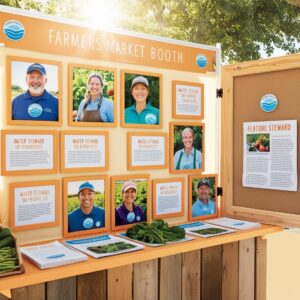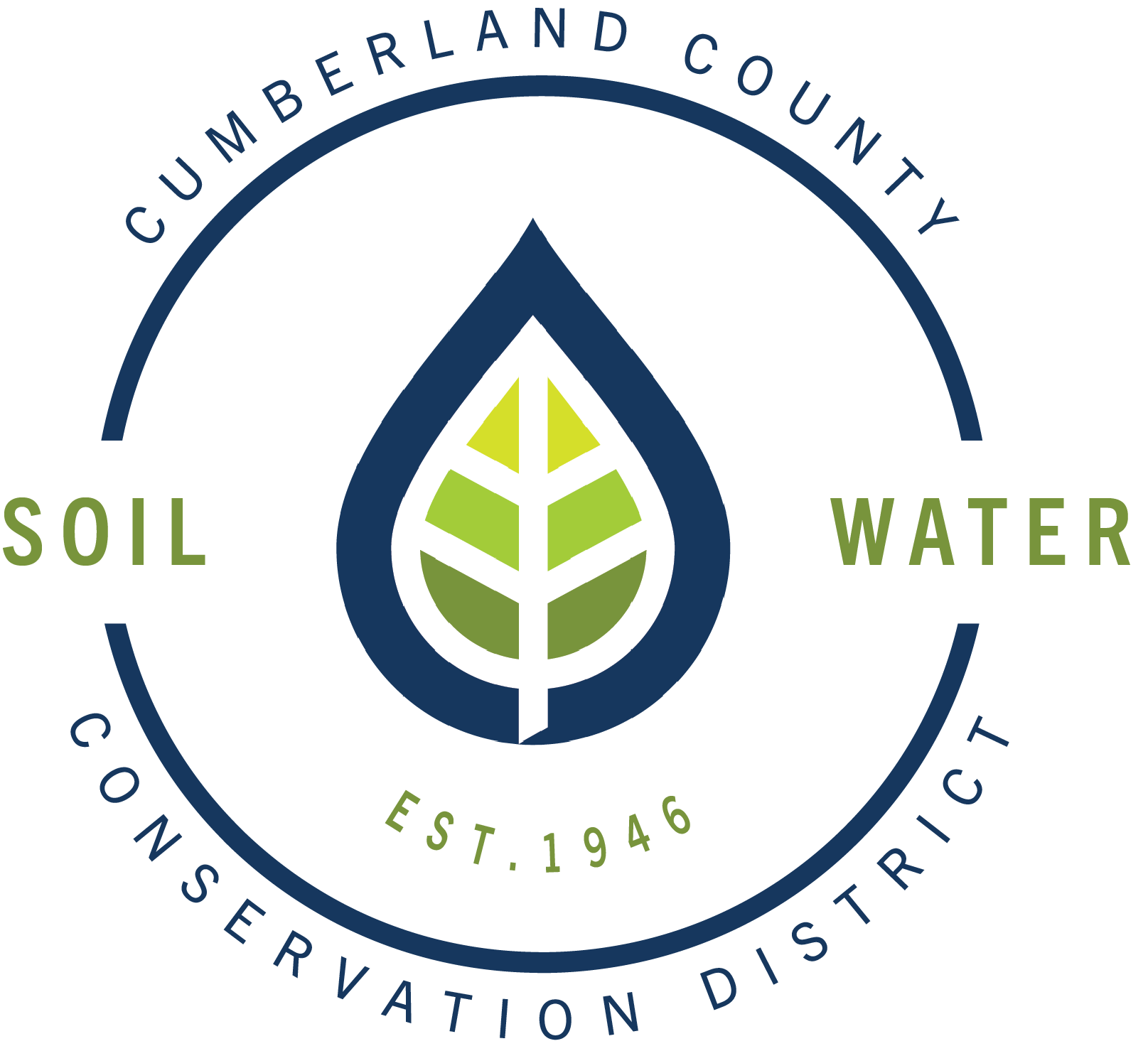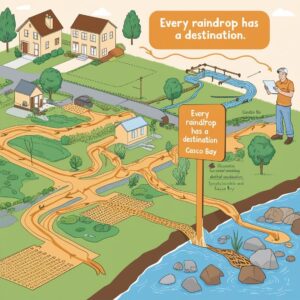Growing on the Edge: How Cumberland County, Maine Used Communication to Protect Water Quality through Urban Agriculture
 Between 2019 and 2022, Cumberland County, Maine, launched an innovative and strategically communication-centered campaign to address a growing environmental challenge: nonpoint source pollution from suburban agricultural activity. As development expanded into the outskirts of Portland and surrounding municipalities, small-scale agriculture, hobby farms, and intensively landscaped residential areas grew in number. While often seen as environmentally neutral or even beneficial, these spaces contributed significantly to nutrient runoff, sedimentation, and pesticide contamination of local waterways.
Between 2019 and 2022, Cumberland County, Maine, launched an innovative and strategically communication-centered campaign to address a growing environmental challenge: nonpoint source pollution from suburban agricultural activity. As development expanded into the outskirts of Portland and surrounding municipalities, small-scale agriculture, hobby farms, and intensively landscaped residential areas grew in number. While often seen as environmentally neutral or even beneficial, these spaces contributed significantly to nutrient runoff, sedimentation, and pesticide contamination of local waterways.
To address this, the Cumberland County Soil & Water Conservation District (CCSWCD) spearheaded the Urban Edge Farming & Water Quality Initiative, a community-based effort to promote sustainable growing and landscaping practices in the urban-suburban fringe. The program didn’t rely on enforcement or blanket policy directives. Instead, it leveraged communication as its cornerstone—building trust, providing localized education, and turning everyday growers and homeowners into informed water stewards.
What followed was not just a technical fix but a cultural shift in how suburban communities relate to agriculture, conservation, and each other.
The Initiative: Structure, Mission, and Governance
The Urban Edge Farming & Water Quality Initiative was created to bridge two often separated conversations: sustainable agriculture and urban water management. Spearheaded by CCSWCD, the program was structured to support local growers operating near sensitive watersheds in Cumberland County.
Its objectives included:
- Improving Water Quality: Mitigating fertilizer and herbicide runoff into streams, wetlands, and ultimately Casco Bay.
- Educating Growers: Delivering tailored resources and training to suburban farmers on environmentally responsible practices.
- Promoting Sustainable Landscaping: Encouraging low-impact land management techniques among both growers and homeowners.
The program was designed in close collaboration with local watershed groups, urban planners, and agricultural educators. Rather than approaching water quality through regulation alone, the initiative took a support-based approach, using education and voluntary practice adoption as the foundation for change.
A Communication-Centered Approach to Bridging Gaps
Rather than treating communication as an afterthought, the initiative placed it front and center—recognizing that education and outreach were as vital as the scientific data driving the program.
Accessible Training and Resources
One of the first steps was developing a suite of educational tools designed with—and for—the target audience. These resources avoided jargon, relied on local examples, and incorporated visuals that reflected the specific crops, soils, and microclimates of Cumberland County.
- Workshops and Demonstrations: Hands-on events helped translate technical concepts into real-world action. Farmers could see soil testing in action, learn about buffer strip planting, or understand fertilizer timing and application methods.
- Tailored Support: CCSWCD didn’t just host events; they followed up with one-on-one consultations to help growers troubleshoot problems and implement changes at their own pace.
This personalized approach ensured the communication didn’t stop at information—it led to action.
Visible, Place-Based Messaging
Public awareness was critical to creating a culture of water stewardship.
- Signage at Farmers Markets and Garden Centers: By placing educational materials in places frequented by both producers and consumers, the initiative expanded the sphere of influence beyond the farming community.
- Storytelling with Maps: One of the campaign’s signature tools was watershed mapping that visually demonstrated how a single raindrop could carry pollution from a garden to the bay. This simple but powerful image helped people internalize their connection to water quality.
By reframing the issue from compliance to contribution, the messaging shifted public perception. It wasn’t about what residents couldn’t do—it was about what they could do to protect their environment.
Why It Worked
This approach worked because it localized complex issues and made them emotionally and practically relevant. The initiative didn’t just deliver facts—it created a compelling story, supported by credible messengers and actionable steps.
Modeling Participatory Governance Through Grower Engagement
Beyond communication, the initiative’s power came from deep community engagement. CCSWCD treated growers as partners, not subjects, recognizing that the best solutions would come from those who understood the land firsthand.
Co-Design with the Agricultural Community
Throughout the initiative, CCSWCD used feedback loops such as:
- Pre- and post-event surveys
- Focus groups
- Ongoing conversations with growers
For instance, when feedback revealed confusion around alternative fertilizers, the campaign pivoted to include more detailed comparison guides and examples from local peers who had already adopted such practices.
This adaptive design process ensured that the campaign remained relevant and responsive, even as conditions evolved.
Empowerment Over Enforcement
Unlike regulatory approaches that mandate compliance, this campaign used a collaborative tone:
- Recognition over Regulation: Farmers who implemented new practices were publicly acknowledged through newsletters, signage, and press coverage.
- Incentives and Support: CCSWCD provided technical assistance, connections to cost-share programs, and recognition to encourage adoption of best practices.
This strategy created a cultural shift where adopting sustainable practices became a source of community pride rather than administrative burden.
Why It Worked
When people see themselves in the message and the messenger, they are more likely to trust and act. By involving growers from the start and maintaining open lines of communication, the campaign gained legitimacy and staying power.
Impact and Replication
By 2022, the initiative had left a measurable imprint on both the environment and community behavior.
Outcomes
- Increased Awareness: Follow-up surveys revealed that more farmers understood how their practices affected water quality, and many reported reducing fertilizer use.
- Behavioral Shifts: Over 45 growers implemented sustainable changes like cover cropping, altered pesticide timing, and installation of vegetative buffers.
- Expanded Reach: The initiative also influenced suburban homeowners, encouraging eco-friendly landscaping techniques such as rain gardens, composting, and native plant use.
Model for Replication
The Urban Edge Farming model is now being examined by other conservation districts in Maine and the Northeastern U.S. Its structure—voluntary, communication-led, and community-driven—is being seen as a cost-effective and scalable model for areas where low-density agriculture abuts sensitive water systems.
Why It Worked
This program was successful because it aligned messaging with behavior change. It didn’t just distribute brochures—it built a movement through storytelling, trust, and shared responsibility.
 Communication Lessons from Cumberland County
Communication Lessons from Cumberland County
This initiative holds important lessons for agencies, nonprofits, and conservationists working on similar issues:
- Hyperlocal Relevance Matters
Generic messaging fails to resonate. Grounding communication in the specific crops, challenges, and values of a local community increases its effectiveness.
- Show, Don’t Just Tell
Visual aids like watershed maps and “before-and-after” images helped translate abstract science into tangible understanding.
- Trust the Messenger
Peer-to-peer learning was one of the most powerful tools in the campaign. Farmers trust other farmers, and community members trust people they know.
- Evolve with Your Audience
Campaigns must remain dynamic. Continuous feedback and data monitoring enabled the initiative to adjust its strategies in real time.
Conclusion: A Blueprint for Water Stewardship Through Communication
The Urban Edge Farming & Water Quality Initiative proves that communication is not a peripheral tactic—it is the core mechanism through which change takes root.
In a rapidly urbanizing world, where the edges between cities and farms are increasingly blurred, this model provides a roadmap. By listening, co-designing, and celebrating successes, Cumberland County built not just a cleaner watershed—but a stronger, more informed community.
The lesson is clear: Empowered communities protect what they understand. And when the message is clear, the actions follow.
Ready to Elevate Your Agency’s Public Communication?
We understand the unique challenges state and local government agencies face—from complex issues to diverse community needs. Our comprehensive approach can help you transform the way you connect with constituents, improve transparency, and highlight the valuable work your agency does every day.
Interested in learning more? Reach out to us today for a consultation. We’d love to discuss how our services can support your goals and help you build lasting trust with the communities you serve.



 Communication Lessons from Cumberland County
Communication Lessons from Cumberland County

